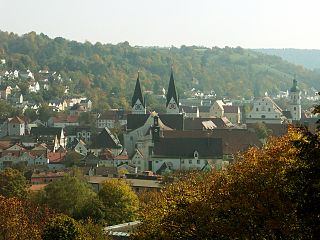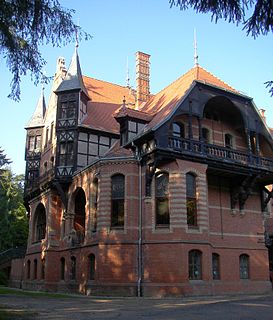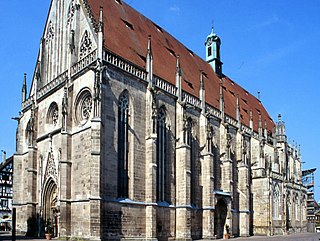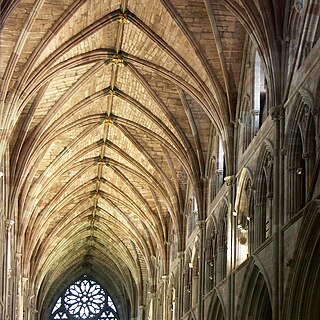
Albrecht Dürer, sometimes spelled in English as Durer or Duerer, was a German painter, printmaker, and theorist of the German Renaissance. Born in Nuremberg, Dürer established his reputation and influence across Europe when he was in his twenties due to his high-quality woodcut prints. He was in communication with the major Italian artists of his time, including Raphael, Giovanni Bellini and Leonardo da Vinci, and from 1512 was patronized by Emperor Maximilian I. Dürer is commemorated by both the Lutheran and Episcopal Churches.

Conrad Celtes was a German Renaissance humanist scholar and poet of the German Renaissance born in Franconia. He led the theatrical performances at the Viennese court and reformed the syllabi. In 1500, he published Tacitus' "Germania" and his rediscovered works and wrote the "Quatuor libri amorum" in 1500, after the model of Ovid.

Gothic architecture is an architectural style was particularly popular in Europe from the late 12th century to the 16th century, during the High and Late Middle Ages, surviving into the 17th and 18th centuries in some areas. It evolved from Romanesque architecture and was succeeded by Renaissance architecture. It originated in the Île-de-France region of northern France as a development of Norman architecture. The style at the time was sometimes known as opus Francigenum ; the term Gothic was first applied contemptuously during the later Renaissance, by those ambitious to revive the Grecian orders of architecture.

The Cherusci were an early Germanic people that inhabited parts of the plains and forests of northwestern Germany, in the area possibly near present-day Hanover, during the first centuries BC and AD. Ethnically, Pliny the Elder groups them with their neighbours, the Suebi and Chatti, as well as the Hermunduri, as Hermiones, one of the Germanic groupings said to descend from an ancestor named Mannus. They led an important war against the Roman Empire. Subsequently, they were probably absorbed into the late classical Germanic tribal groups such as the Saxons, Thuringians, Franks, Bavarians and Allemanni.

Güstrow is a town in Mecklenburg-Vorpommern, Germany. It is capital of the Rostock district; Rostock itself is a district-free city and regiopolis.

The Germania, written by the Roman historian Publius Cornelius Tacitus around 98 AD and originally entitled On the Origin and Situation of the Germans, was a historical and ethnographic work on the Germanic peoples outside the Roman Empire.

Eichstätt is a town in the federal state of Bavaria, Germany, and capital of the district of Eichstätt. It is located on the Altmühl river and has a population of around 13,000. Eichstätt is also the seat of the Roman Catholic Diocese of Eichstätt.

The Byzantine Revival was an architectural revival movement, most frequently seen in religious, institutional and public buildings. It incorporates elements of the Byzantine style associated with Eastern and Orthodox Christian architecture dating from the 5th through 11th centuries, notably that of Constantinople and the Exarchate of Ravenna. Neo-Byzantine architecture emerged in the 1840s in Western Europe and peaked in the last quarter of the 19th century in the Russian Empire, and later Bulgaria. The Neo-Byzantine school was active in Yugoslavia between World War I and World War II.

The German Renaissance, part of the Northern Renaissance, was a cultural and artistic movement that spread among German thinkers in the 15th and 16th centuries, which developed from the Italian Renaissance. Many areas of the arts and sciences were influenced, notably by the spread of Renaissance humanism to the various German states and principalities. There were many advances made in the fields of architecture, the arts, and the sciences. Germany produced two developments that were to dominate the 16th century all over Europe: printing and the Protestant Reformation.

Flamboyant is a form of late Gothic architecture that developed in Europe in the Late Middle Ages and Renaissance, from around 1375 to the mid-16th century. It is characterized by double curves forming flame-like shapes in the bar-tracery, which give the style its name; by the multiplication of ornamental ribs in the vaults; and by the use of use of the arch in accolade. Ribs in Flamboyant tracery are recognizable by their flowing forms, which are influenced by the earlier curvilinear tracery of the Second Gothic styles. Very tall and narrow pointed arches and gables, particularly double-curved ogee arches, are common in buildings of the Flamboyant style. In most regions of Europe, Late Gothic styles like Flamboyant replaced the earlier Rayonnant style and other early variations.

Jagdschloss is the German term for a hunting lodge. It is a schloss set in a wildlife park or a hunting area that served primarily as accommodation for a ruler or aristocrat and his entourage while hunting in the area.

Peter Flötner, also Flatner, Flettner, or Floetner was a German designer, sculptor, and printmaker. He was a leading figure in the introduction of Italianate Renaissance design to sculpture and the decorative arts in Germany, competing in this regard with the Vischer Family of Nuremberg. He designed and produced work in a wide range of media, but "seems to have made only a modest living", unlike many of his contemporary artists.
Willibald Sauerländer was a German art historian specializing in Medieval French sculpture. From 1970 to 1989, he was director of the prestigious Zentralinstitut für Kunstgeschichte, Munich.
Norbert Nussbaum is an architectural historian specialising in the Gothic who is a professor at the Kunsthistorisches Institut, University of Cologne.

Heinrich Parler the Elder, was a German architect and sculptor. His masterpiece is Holy Cross Minster, an influential milestone of late Gothic architecture in the town of Schwäbisch Gmünd, Baden-Württemberg, Germany. Parler also founded the Parler family of master builders and his descendants worked in various parts of central Europe, especially Bohemia. His son, Peter Parler, became one of the major architects of the Middle Ages. The family name is derived from the word Parlier, meaning "foreman".

Tucher is a noble patrician family from Nürnberg. Like the Fugger and Welser families from Augsburg, their company run trading branches across Europe between the 15th and 17th centuries, although on a somewhat smaller scale. The Protestant family played an import part in the economical and cultural development as well as in local politics. They were admitted to the governing council of the free imperial city since 1340, a hereditary privilege. After the acquisiton of Simmelsdorf Castle in 1598, the family was named Tucher von Simmelsdorf and ennobled in 1697. In 1815, they became Bavarian barons.

The Altenberger Dom is the former abbey church of Altenberg Abbey which was built from 1259 in Gothic style by Cistercians. Listed as a cultural heritage, it is located in Altenberg, now part of Odenthal in the Rheinisch-Bergischer Kreis, North Rhine-Westphalia, Germany. Until 1511, the church was the burial site of counts and dukes of Berg and the dukes of Jülich-Berg.

Alain Erlande-Brandenburg was a French art historian and honorary general curator for heritage, a specialist on Gothic and Romanesque art.

St. Martin is a Gothic church and the associated Catholic parish in Lorch am Rhein, Hesse, Germany. In 2002, it became part of the Rhine Gorge, a UNESCO World Heritage Site. The church features the oldest and largest monochrome wood-carved altar in Germany. Its organ from 1984 makes it also a concert venue, where international organists such as Olivier Latry have performed.

The pointed arch is an arch with a pointed crown, whose two curving sides meet at a relatively sharp angle at the top of the arch. This architectural element was particularly important in Gothic architecture. It first appeared in Indian architecture and Islamic architecture as a way of making more decorative windows and doorways, but in the 12th century it began to be used in France and England as an important structural element, in combination with other elements, such as the rib vault and later the flying buttress. These allowed the construction of cathedrals, palaces and other buildings with dramatically greater height and larger windows which filled them with light.






























